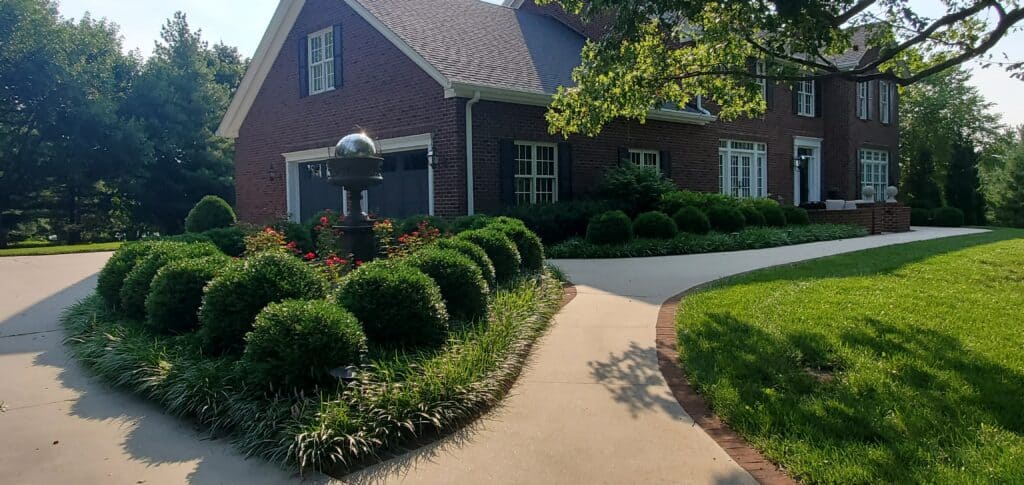Recently, a colleague asked me about plants for tidy gardening. But what is tidy gardening, and how does one achieve it? I have discussed many times my gardening ideals, which include diversity, and lots of plant materials. But I realize there are many homeowners, and some gardeners who prefer to have a tidy look, with spaces between plants and landscape spaces. It may not be my ideal, but for many, tidy gardening is the way to go.
What is tidy gardening? It is gardening or plantings which do not mimic natural settings, but rather go against the flow of things. It includes plants which either are easy to maintain in a specific shape, or are tidy in their habits-neither spreading quickly nor growing out of their desired areas. In short (too late), tidy gardening involves neat and clean landscapes.
Gardening Styles that Create a Tidy Garden
While most landscapes that are low maintenance do not involve tidy gardening, there is a place for it. Mainly in large cities, or housing developments where HOAs have dominion over their homeowners. A few types of gardening styles do actually work to produce this effect, but at a cost of higher maintenance.
Formal Garden Styles
Formal gardens are usually created to match existing architecture of the house it surrounds. Out of 26 popular architecture styles in the United States, 16 are classified mainly as formal, while 10 are considered more likely to have a cottage or informal style garden. If you are wanting to have a tidy garden, try to make sure it matches with the style of your house. That being said, other than just a few styles, most will work very well with any type of formal garden.
What we typically think of as a formal garden includes spaces with straight lines and arcs, long lawns or pools, strong vertical lines, and matching plants in groups of 1s, 2s, and 3s. Plantings are simples, often composed mainly of evergreens and shrubs. Landscape covering is usually rock or organic mulch. Water features include large, multi-tiered fountains, reflecting pools, and lily ponds.

Modern Garden Styles
What many would call modern, are usually made up of plantings that encourage tidy gardening, even if it is higher in maintenance. Modern gardens often incorporate artwork and sculptures, wide open spaces of rock or lawn, and lollipop plantings of smaller trees and shrubs. One of the most important looks of the modern estate is lots of separation between plant materials.
Asian Gardening Style
Asian gardening involves lots of rock, tidy plantings, and water. While many of the plants have artistic forms, they are presented together in such a way as to appear tidy, even if individual plants are not. It is common to see big sweeps of sand or gravel with no plantings at all. And water features are often curved, pulling the eye through the landscape.
Choosing Plants for Tidy Gardening
Once you begin the process of choosing plants for tidy gardening, you realize that many do not work in this way. A lot of plants either require regular shaping and pruning, or deadheading, to be deemed useable for a tidy garden. But there are many plant which will work. Most of them are evergreens. Small trees, lopped into tidy lollipops by nurseries will work at the start, but require regular maintenance. Having a landscape designer to help design your garden may be a benefit for you.
I am going to go into the plants for tidy gardening by sectioning them off into categories of evergreens, deciduous trees and shrubs, and perennials. I will stick to the plants that are best for the Central Great Plains, but feel free to try these in your gardens across the world. There are lots of plants that transcend the hardiness zones of this earth.
Evergreen Trees and Shrubs for Tidy Gardening
Evergreens include both trees and shrubs, and some groundcovers. All of there lend themselves to the tidy garden. They can either stand alone or be placed in small groups in the landscape. Some shearing may be necessary for maximum tidiness.
Evergreen Trees and Shrubs
- North Pole arborvitae – 10-15 feet tall by 3-5 feet wide. Perfect for Zones 3-7.
- Spring Grove arborvitae – 30 feet tall by 12 feet wide. It grows great in Zones 4-8.
- Holmstrup arborvitae – 7 feet tall by 3 feet wide. Grows best in Zones 3-8.
- Planet Earth arborvitae – grows 5 feet tall and wide in Zones 4 to 8.
- Gold Cone juniper – 5 feet tall by 2 feet wide in Zones 2 to 6.
- Taylor juniper – grows 20 feet tall by 4 feet wide. It is best grouped in 2s or 3s. It does well in Zones 4-9.
- Skyrocket juniper – 20 feet tall by 3 feet wide. Best planted in groups and grows in Zones 4-9.
- Spartan juniper – 20 feet tall by 6 feet wide. Zones 4-10.
- Dwarf Alberta spruce – grows 10 feet tall by 6 feet wide in Zones 2-8.
- Freedom boxwood – 5 feet tall and wide in Zones 5-8.
- Independence boxwood – grows 4 feet tall and wide in Zones 5-8.
- Hicks yew – 12 feet tall by 4 feet wide. Zones 4-7.
- White pine – grows 60 to 100 feet tall and 40 to 60 feet wide.
There are a variety of other junipers, arborvitaes, and boxwoods which, when pruned, will work very well in a tidy garden. Caring for these plants means a lot of pruning stray branches. Many of the shrubs grow quicker after pruning, but are otherwise easy to care for.

Deciduous Trees and Shrubs
One of the things about deciduous plants is that they lose their leaves every year. Sometimes all at once, and sometimes over the course of several weeks. Either way, their messiest time of the year is during the fall season. Fall can be difficult for tidy gardening, making it hard for those who cannot stand the mess a little grouchy. Bear with them then as the leaves are blown away.
Choosing plants for the tidy garden mainly means picking plants which can stand alone in a garden, without needing extra propping or staking from other plants. These plants however, often require shearing or pruning several times over the year to maintain that tidy look.
The Plants
- Ninebarks – can bed sheared anytime. Several cultivars are available.
- Weigela – another easily sheared shrub, many cultivars with different leaf/flower colors.
- Korean spice viburnum – easy to prune 2 to 3 times a year, with very fragrant flowers and great fall color.
- Fineline buckthorn – stays narrow and upright, growing 7 to 10 feet tall by 4 feet wide.
- Jade Parade sandcherry grows small, 3 to 4 feet tall and wide.
- Japanese spirea grows 3 to 6 feet tall and wide, depending on cultivar. They need to be pruned only 1 time per year.
- Arrowwood viburnum is easy to prune and shape.
- Panicle hydrangea tree forms can be shaped easily and grow 10 feet tall and wide at the top.
- Crabapples – most varieties can be pruned into lollipops or tidy shapes.
- Matador maple is a narrow and upright maple, growing 40 to 50 feet tall by 30 feet wide.
- Skinny Genes oak is a narrow, upright oak.
- Heartland catalpa grows 40 to 60 feet tall by 20 feet wide.
- Niobe weeping willow is easy to prune and is low on maintenance in wetter areas.
- Saffron Sentinel dogwood grows 40 feet tall by 15 feet wide.

Perennials for Tidy Gardening
Picking perennials (and grasses) for a tidy garden can be difficult, because many perennials do not stand alone in nature. However, thanks to breeding programs such as Proven Winners, we can now find a lot more perennials and grasses which look good alone as well as in groupings. The hardest part for me is always leaving that space in between because, just like trees, other plants like to share space with each other.
Perennials
- Siberian iris – one of the most versatile and upright perennials, they look like grasses when not blooming.
- Ornamental onions – thanks to breeding programs, there are a plethora of these plants available.
- Silver mound – this artemisia stays short and squat and does not require much care.
- Baptisia – despite its size, false indigo can stand alone in the landscape and provide interest from April to October. Simply knock the stems down in November for cleanup.
- Lavender is easy to care for and maintain, requiring little to no watering through the year.
- Kobold liatris – grows 12 inches tall and wide, and will bloom for 4 weeks in early summer.
- American Gold Rush Rudbeckia – what did we do before this cultivar? It stays in a small mound and only a few seeds are viable.
- Salvias – growing 1 to 2 feet tall and wide, salvia only needs cut back 2 times per year.
- Hummelo betony is easy to maintain
Grasses
- Karl Foerster feather reed grass is one of the most widely used upright grasses for a tidy garden look.
- Switchgrass Northwind is steady and upright, growing 5 feet tall by 3 feet wide.
- Standing Ovation little bluestem is the most upright of the little bluestem grasses.
- Prairie dropseed is airy, but it rarely seeds out of its space.
- Bandwidth miscanthus not only is upright, but has sterile seedheads too.

Maintaining the Tidy Garden
One of the most difficult things about tidy gardening is maintenance. Because plants are spaced farther apart, there is more sunlight getting to the ground level in between. This results in more weeds and more weed pressure. And because tidy gardeners want the plants to look neat, more clipping or shearing is necessary than in an informal garden setting.
Keeping the weeds down usually means using more chemical means, or more hand pulling of weeds. Of all the landscapes I have maintained over the years, the ones which required the most hand weeding were those with lots of space between the plants. While either organic mulch or rock is used as a landscape covering in tidy gardens, rock is often portrayed as more beautiful. What I know for sure is that it is more beautiful, if maintained regularly. It also gets weedier faster than regularly mulched areas.
Conclusion
Tidy gardening is not for everyone, but for those either willing to pay for more maintenance or those willing to do more. Plants are not always a cookie cutter thing which can be planted and left alone. But if done right, a tidy gardening plan can make certain architectural elements of the house and landscape stand out. Be sure to know the risks and rewards before beginning though.
Happy gardening!




